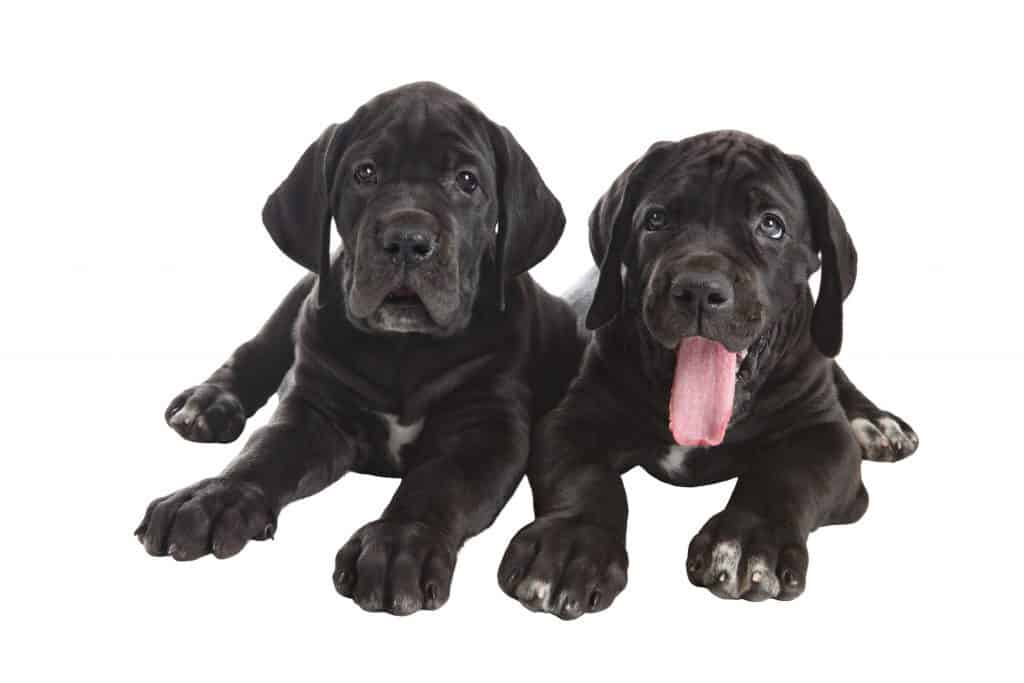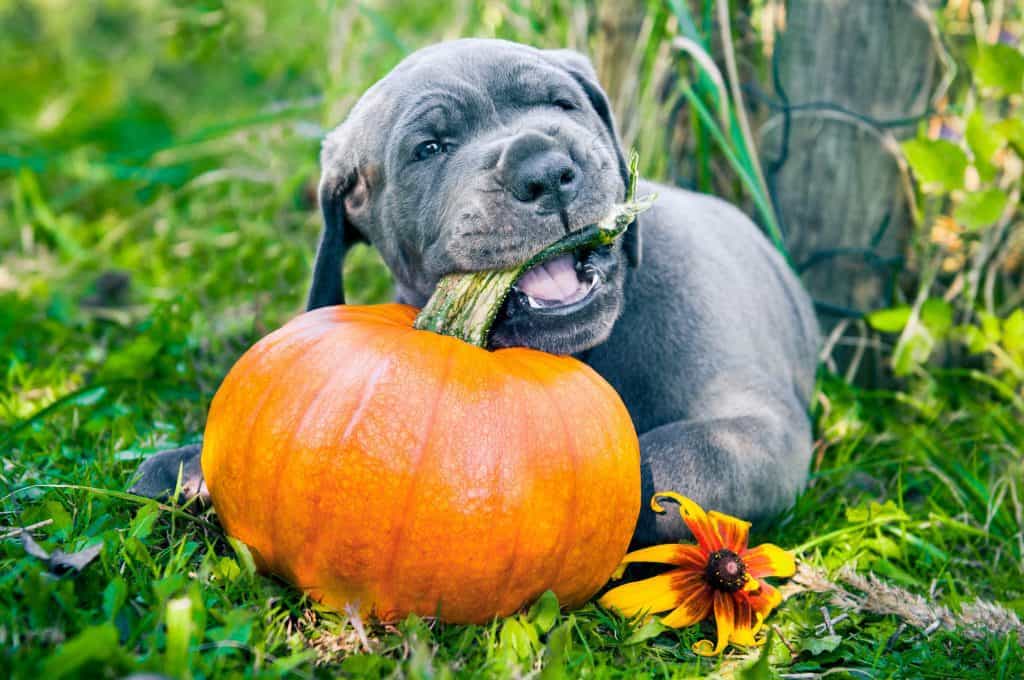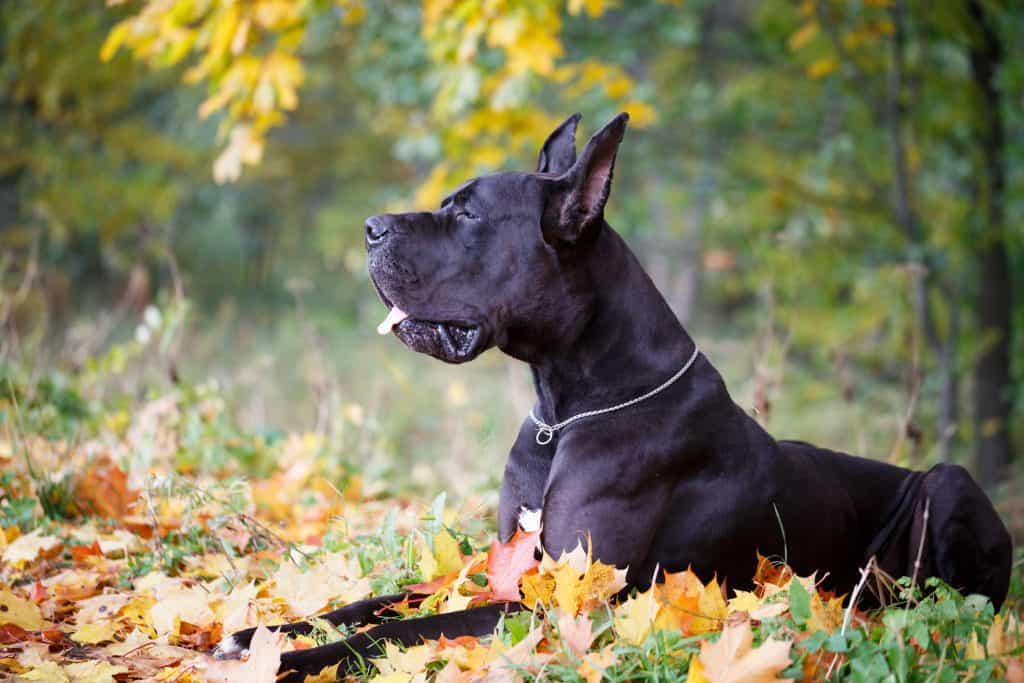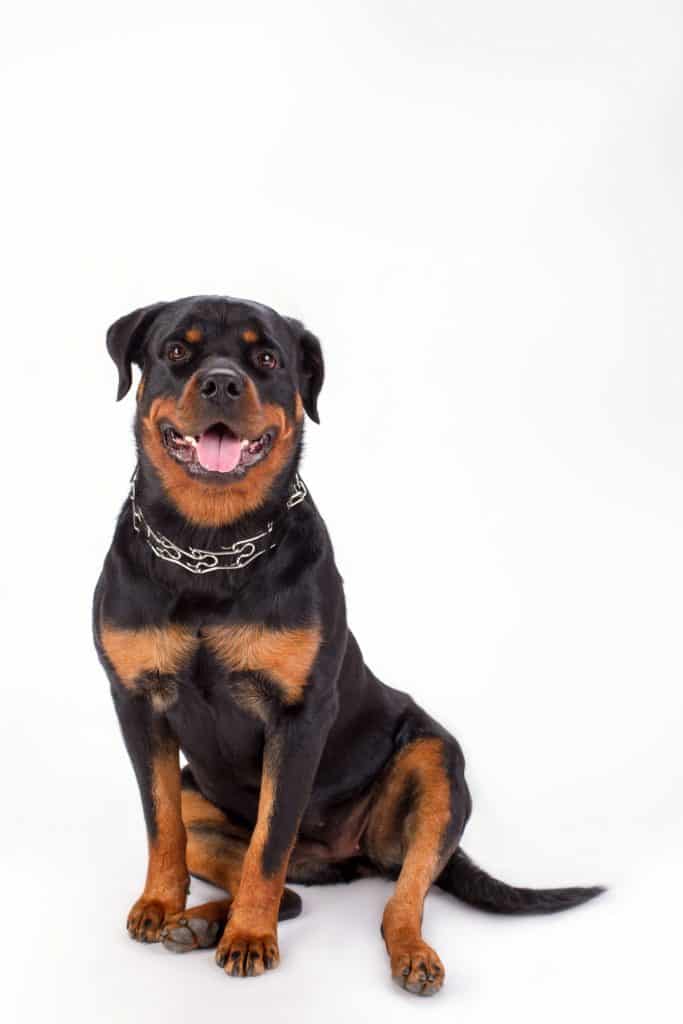Mini Great Danes: Everything You Could Want to Know
Great Danes truly are gigantic dogs. Although, what if you are in search of a best friend with the love, affection, and look of the Great Dane, but not the size?
Mini Great Danes, while cute, are the result of a birth defect known as Dwarfism or the intentional breeding of two or more runts, who are often very unhealthy. They are sadly at risk for a plethora of health problems and a shortened life expectancy.
If you are considering adopting or buying a mini Great Dane, there is a lot you should consider before making the final decision.
I’ve compiled all the information I could about miniature Great Danes right here, just for you!
What is a Mini Great Dane?
First of all, if you are expecting to find a Great Dane small enough to fit in your purse, even if it’s a large purse, you are unfortunately going to be disappointed.
Mini Great Danes are rare, and if you do find one in good health, it’s definitely not going to be a teacup dog!
It’s likely that your Great Dane will be about 3 – 4 inches shorter than normal, so about 25 – 29 inches tall. That’s still pretty dang big.
Mini Great Danes are not a breed that is recognized by the AKC.
A Mini Great Dane is usually just the offspring of two runts or a puppy that suffers from Dwarfism.
Sometimes Mini Great Danes are really a mixed breed Great Dane with some other smaller dog. They may be more mutt than anything, but if these lovable creatures look like a Great Dane but smaller, they can be put in this unofficial category.
Mini Great Danes
Mini Great Danes are exactly what they sound like, a mini Great Dane!
Mini Great Danes are considered “mini” in several different circumstances. The runt of a litter might be considered a Mini Great Dane.
Otherwise, a Mini Great Dane can be specifically bred by breeding numerous smaller Great Danes until they are born to dwarfism, due to smaller than average parents.
Once again, this is discouraged. Great Danes born to dwarfism can be dangerously unhealthy.
Mini Great Dane Temperament
Great Danes have many nicknames. One of the most commonly used is the gentle giant. Although, what is a gentle giant like when it’s not so giant? Is the giant-ness correlated with the gentleness? Fortunately, no!
Purebred mini Great Danes, if they turn out healthy, will have a temperament almost identical to larger Great Danes.
Great Danes were originally bred in Germany and England, used as companions to hunters and royalty.
EDITOR’S NOTE: If you are looking for a full resource to answer your Great Dane questions, this book is an excellent resource!
Hunters sought out a dog that had the endurance, strength, and soul to accompany them on long trips chasing down animals such as deer, wolves, and most famously, the European Wild Boar.
The Great Dane was eventually chosen because of its size, strength, and exceptional loyalty to their owners.
Soon after, the “boarhound” was renamed the “German Mastiff”, and owned almost exclusively by royalty and the elite upper class.
Eventually, the newly named Great Dane was popularized around the world as a breed of dog that would provide gentle and playful love and affection, while at the same time providing a sense of safety and security to the owners.
The Mini Great Dane is practically identical in every way but one: its size (obviously).
The Mini Great Dane provides the gentle love and affection as a fully grown Great Dane but can be unpredictable when it comes to security.
If your Mini Great Dane is truly mini, it is possible he could be less confident in his ability to provide security. His bark may be worse than his bite, especially if he is facing issues common to mini-bred dogs.

Mini Great Dane Mixes
When Great Danes are purposely bred with smaller breeds in order to create a miniature Great Dane, results can vary greatly.
They can also be considered mini by mixing a Great Dane with a smaller dog, such as a Boxer or Siberian Husky.
Often, results of mixing a Great Dane and a smaller breed result in a more medium or large sized dog.
The most popular smaller breeds mixed with the Great Dane include:
Great Dane Siberian Husky Mix
The Great Dane, when mixed with a Siberian Husky, will likely turn out about the size of a large husky or about 24 inches to 28 inches in size and around 120 lbs.
With features similar to a Husky, with the body type of a Great Dane, this mix will leave you satisfied with its gentle Great Dane-like behavior, as well as its occasional hyperactivity like that of the Husky.
Great Dane Boxer Mix
A Great Dane Boxer mix is commonly referred to as a Boxane but some may consider this dog to be a mini Great Dane. This adorable mix will likely stay a bit smaller for the first 2-3 years due to its Boxer blood.
A mix of this size will likely be 80+ lbs and 25 – 28 inches tall.
The Boxane, fortunately, will also have a shiny, light fur coat that will be easy to care for.
Great Dane Rottweiler Mix
Known as the Weiler Dane, this may be one of the smaller mixes you can achieve when mix breeding a Great Dane.
The Weiler Dane will likely still turn out fairly large, muscular, and tough.
With the love, care, and the fierceness of both the Great Dane and the Rottweiler, you can be sure that this mix will love and protect you to the ends of the Earth!
This mix will also likely enjoy spending his time inside with you, while still getting plenty of time to play outside!
What Miniature Dog Breeding Really Is
So, what is a “mini” dog breed, anyway? Is it just a shrunken down version of a dog? Is it a puppy? Have breeders discovered the shrink ray from the movie Despicable Me?
Well, the shrink ray is still yet to be found, but breeders have taken it upon themselves to create miniature dogs.
Miniature breeding is not recommended. Dogs of such small size often face many health risks and can cause even worse issues in their offspring.
For thousands upon thousands of years now, dogs have been best friends to humans. They have personalities and feelings; they understand us and love us with a love that can only be compared to… well… a dog’s love.
A “mini” dog is a name given to any dog of particularly small size.
Often, this can be referring to the runt of a litter, which could be born dangerously underweight or just generally smaller than its brothers and sisters.
Mini breeds have also been discovered in other ways…
At one point, humans began searching for smaller breeds of dogs that could help hunt rodents in small places, or simply searching for smaller breeds that they could carry around in their purse!
People then began breeding dogs of smaller sizes and breeds to come up with a number of desired physical characteristics.
This began with popular dogs such as the mini pinscher, schnauzer, bull terrier, and a few others.
Now, even the chihuahua has been miniaturized enough to fit in a teacup!
This is often not recommended by breeders because dogs of abnormally small size often face many health risks and can cause even worse issues in their offspring.
Your Boxane will be adorable and loving, though possibly a bit troublesome at times.
In conclusion, do not expect to find yourself a tiny Great Dane. Purebred mini Great Danes are hard to come by in shelters and will usually have a ton of health risks if you intend to get one from a breeder.
How Can I Find One?
Dog breeders are common throughout the United States. Great Dane breeders are somewhat common. These breeders are responsible for the health and lives of their dogs.
When a new dog is bred, the dog is raised with a very strict diet and is given numerous health tests that can cost thousands of dollars! Many breeders register their dog’s pedigree with the AKC.
Breeders are required to keep their dogs in the best health possible for the sake of the dogs and any future owners.
Because of this, it is not considered proper breeding to breed miniature dogs in order to intentionally cause defects that will make a dog smaller.
Although, some breeders still do this!
A backyard breeder is an amateur dog breeder who’s breeding is considered unethical due to selective or misguided breeding that can result in dogs with extremely poor health.
Backyard breeders most often do not register their dogs’ pedigrees or take them through the necessary health checks.
Mini Great Danes are a small market (no pun intended) and can be very rare to come by.
If a Mini Great Dane is successfully bred, it is likely a result of dwarfism or other birth defects, violating a number of moral codes set by the dog breeders of America.
When doing my research for this article, I contacted JGD Great Danes, a breeder out of Central California.
The woman I spoke to explained that as a breeder herself, she is expected to meet a level of standards.
Every breed of dog is required to get health tests done by the breeder. The Great Dane must have the following tests performed.
- Hip Evaluation
- Ophthalmologist Evaluation
- Thyroid Evaluation
- Cardiac Exam

Caring for a Mini Great Dane
We’ve now covered the important facts about Mini Great Danes affected by dwarfism. They are fragile animals!
It is frowned upon to intentionally breed a Great Dane with dwarfism, but if you do happen to adopt one, or if you already do have one, how do you properly care for it?
Caring for a Great Dane requires a lot of extra work and attention. Not to mention extra money too with all of the health problems they will likely face.
Caring for a Great Dane with dwarfism will be work as well! Facing health issues and taking good care of their already weak immune system will require special attention at least until adulthood, depending on the dog.
There are many signs to look our for in dogs with dwarfism.
A few of these signs include:
- Disproportionate head in comparison to the body
- Puppy teeth not falling out
- Issues gaining weight or keeping food down
- Crooked teeth
- Bulging eyes
- Disfigured legs, back, or neck
- Genital disfigured – un-descended testicles
- Skin pigment irregularities or scaly/dry skin
If your Great Dane seems to be suffering from dwarfism or any of the above descriptions, you should take him in to see a veterinarian as soon as possible.
Describe the symptoms, severity, and how it affects your dog’s daily life.
Growth Hormones may be an option provided by your veterinarian. Your dog’s stunted bones could be grown and strengthened by these hormones.
Most growth hormones for dogs are harvested from pigs.
Don’t worry, your dog won’t start growing pig body parts! Hormones can be a huge help to dwarf dogs. Although, they can also pose some risks, including serious allergic reactions.
Check with your veterinarian to see if growth hormones are right for your Great Dane. Mini Great Danes should be taken in for check-ups annually.
Do not over-exercise your mini Great Dane.
Diet is also very important to keep your dog healthy. Because Dwarfism causes so much weakness in the body and skeletal structure, healthy, organic foods should be fed to a Mini Great Dane.
Foods with organic ingredients, extra fats, and extra proteins will help to build the muscle and immune system of your pup.
Lastly, dwarfism will affect the strength of his immune system, so be careful exposing your Great Dane to any harmful chemicals or foods that might pose a risk.
Basically, you just have to be overprotective and careful with your mini puppy. These are fragile dogs, and they need your love!

Are there Health Risks?
Everyone loves miniature versions of things. Cars, houses, and dogs are just a few of everyone’s favorite things to have miniature versions of.
Although, even if miniature versions of dogs are as cute as can be, they can have some severe health risks. Mini Great Danes have a mixture of advantages and disadvantages to them.
Below, I’ve compiled all of the pros and cons to owning a Mini Great Dane.
| Pros | Cons |
| Less risk of bloat | Dwarfism- numerous individual risks |
| Less risk of hip dysplasia | Severely shorter life expectancy |
| Less risk of Cardiomyopathy | Taurine Deficiency (causes DCM) |
| Possible body disfigurements |
The Good Stuff
Large dogs, while adorable, can have a number of risks that come with them.
One of the leading causes of death for the Great Dane is bloat. Bloat is a condition many large dogs encounter when eating too much food in a short period of time.
When experiencing bloat, the dog’s stomach is filled with excess gas, expanding and swelling the stomach to the point where it can twist, and can become lethal to the dog.
Unfortunately, this is a fairly common experience for many large dogs when owners simply leave out large amounts of food for the dog to eat as it pleases.
One of the benefits to having a Mini Great Dane is decreased risk of bloat.
Although, a Mini Great Dane will still be somewhat large and could still be at risk. Because of this, it is important that your Great Dane is fed in several smaller meals throughout the day rather than one or two large meals.
Other common risks of the Great Dane is hip dysplasia and cardiomyopathy.
Hip dysplasia is a hip socket irregularity. Often, hip dysplasia is either due to the large stature of the Great Dane and its weight to muscle ratio, or passed down by parents who had the same problem.
Cardiomyopathy is a disease of the heart muscle resulting in a large heart, occurring occasionally at old age in larger dogs.
Fortunately for Mini Great Danes, their smaller size will put them at a much lower risk of hip, joint, or certain heart problems.
The Bad Stuff
Mini Great Danes seem to solve a lot of problems with normal Great Danes. Although, Mini Great Danes are actually at risk for many other issues.
There is a lot more “bad stuff” than good stuff it seems with these poor minis.
A purebred Mini Great Dane is most likely going to be the result of the runt of a litter, possibly affected by pituitary dwarfism, or the result of the breeding of several generations of smaller Great Danes (likely a lot of runt ancestry).
Runts can often face many severe health issues.
The most common health problems faced by runts include hypoglycemia, heart defects, calcium deficiencies, and liver shunts. These problems can be difficult, but not impossible to face as an owner.
Runts need special care when it comes to feeding them and keeping them warm and healthy.
Pituitary Dwarfism is an unfortunate condition in which a dog is born with a deficiency of a growth hormone. This can cause a number of health problems including underdeveloped kidneys, slow intelligence, and many more.
The average Great Dane’s life expectancy is between 7-10 years.
If raised, fed, and treated properly, a Great Dane can live as long as 15 years! The oldest Great Dane to be recorded died at 15, although there have been rumors of Great Danes that have lived as long as 17 years!
Because Mini Great Danes likely are affected by dwarfism or selective breeding, their health issues can drastically affect their life expectancy. Your companion will probably not live to make it to even 7 years old.
Mini Great Danes can be known to die at random times due to Dilated Cardiomyopathy (DCM).
DCM is a heart disease caused by a lack of taurine. Taurine is an amino acid found in dogs that helps regulate normal heart function and fat digestion.
Taurine can be found in some food but is usually needed as dogs’ bodies create it themselves.
Unfortunately, as a result of dwarfism or poor breeding, many breeds can be born or raised with a taurine deficiency that cannot be made up for through food and can cause death at random times in the dog’s life.
Other birth defects common among dwarfs or poorly bred dogs include blindness, deafness, disfigured legs, and other body parts, and many more.
The bottom line here is that breeding miniature dogs, especially Great Danes, can post huge risks to the dogs and the entire breed itself in longterm if it is popularized.
One example of this is the pug.
Pugs are adorable! They are lovely little dogs to have running around your house.
Pugs originated in China as early as 400 B.C. They were popular due to their playfulness, sturdiness, minimal exercise requirement, and small size. As time went on, the pug spread to Japan, Russia, and Europe.
Ultimately, as a result of hundreds upon hundreds of years of breeding the pug, some were inbred to achieve certain physical qualities and they now commonly face breathing problems from their facial structure.
Unfortunately, this has been an issue among many other overbred and inbred dogs, such as the bull terrier, boxers, or rottweilers. These are now known as brachycephalic dogs.
Great Danes can face similar issues if poor breeding standards are carried out to get desired physical appearances. Mini Great Danes might be cute, but searching them out and putting them in high demand can seriously damage the Great Dane breed.
Less Risky Options
Yes, a Mini Great Dane seemed like a great idea in the beginning! Although, maybe you’d like to explore your options now that you have more information.
Here are a few options that might help you find what you’re looking for!
1. Great Dane

- Height- 28-32″
- Weight- 100-200 lbs
What’s so bad about a regular Great Dane? They are adorable, loving, and protective. Yes, the size can be an issue, but Great Danes are people pleasers!
Great Danes are smart and capable enough to be trained to respect your household while still providing all the love and affection that comes with a Great Dane.
I wrote another article going into more detail about Great Dane temperament. Check it out!
2. German Shepherd

- Height- 22-26″
- Weight- 49-88 lbs
If you are looking for a dog that isn’t the size of a Great Dane but will love you and protect you with the spirit of a Great Dane, maybe the German Shepherd is the one for you.
The German Shepherd is a curious and intelligent dog. They are strong, capable, and active.
As one of our amazing writers said in her article on German Shepherd Temperament, “Not only are German Shepherd’s cute and cuddly when they are puppies, but they also grow into strong and protective adults who will work tirelessly for their owners’ success and happiness.”
3. Rottweiler

- Height- 22-27″
- Weight- 77-130 lbs adult
You’ve probably seen plenty of movies in which a Rottweiler plays a role as an intimidating guard dog somewhere and they are in the right place!
Rottweilers are incredibly obedient. They can become emotionally attached to their owners and will protect them to the ends of the Earth. Unfortunately, this can cause aggressive tendencies.
Arlene, one of our other writers, wrote an article about Golden Rottweilers. This is a mix of a Golden Retriever and a Rottweiler. This mix brings out the best in both breeds including the love, playfulness, and protectiveness
4. Boxer

- Height- 21-25″
- Weight- 55-71 lbs
How about a boxer?! These brave canines provide an abundance of love, affection, and faithfulness to their family while also offering energetic protection every day of the week.
Boxers are known to be great dogs for families. Much like Great Danes, they will get along great with your kids! They are built with a strong body that will love to exercise with you!
They are not as tall as full size Great Dane which is probably what you are looking for.
5. Doberman

- Height- 24-28″
- Weight- 71-99 lbs
Great Danes are great, but if you don’t want a Great Dane, a Doberman Pinscher might be the right dog for you!
They have a pretty similar appearance to Great Danes, especially to an untrained eye. So if it’s the look you are going for, then this is the closest, healthiest thing you can get to a Mini Great Dane.
Dobermans have a temperament much like that of Great Danes as well. They have a special love for human companionship while also providing consistent security and safety.
Typically, Dobermans are thought of as vicious and dangerous, but as long as they are trained properly, they are just as gentle, loving and caring as Great Danes.
Good Luck!
Well folks, there you have it! Miniature Great Danes will love you perpetually for taking care of them, but they will come with a number of health risks.
Try not to perpetuate poor breeding.
If you have a Great Dane affected by dwarfism or if it has been selectively bred to its size, be sure to regularly check up with your veterinarian about what you can do to better and lengthen the life of your dog.

